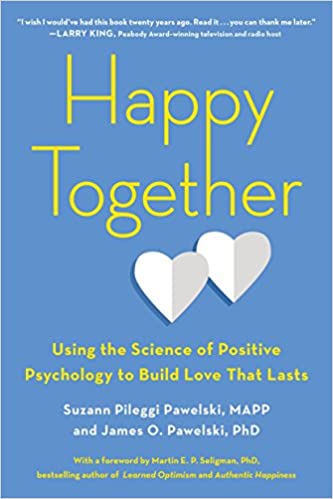Happy Together by Suzann Pileggi Pawelski & James Pawelski
The Book in 1 Sentences
Happy Together: Using the Science of Positive Psychology to Build Love That Lasts
“We are now excited to be able to present this work in book format. And we offer it to all those who are—or hope to be—in romantic relationships and want to make them the happiest, healthiest, and most fulfilling they can be.
We want to be clear we are not claiming that we have it all figured out, that our relationship is one blissful moment after another, and that if you follow our instructions, you too will live happily ever after.
(Trust us, it’s not sunshine and rainbows all the time for us, either!) Instead of fairy-tale endings, we believe in brave beginnings and informed efforts, not so we can magically find the relationship of our dreams, but so we can wisely create beautiful relationships in the real world.
Note that this book is not titled 13 Steps to a Blissful Marriage, The Complete Guide to Happily Ever After, or Everything You Need to Know About Romantic Relationships. Although such titles seem appealing in the easy promises they offer, we believe they are fundamentally misleading.
Marriages are not meat loafs, in which mastering a few steps will yield perfect results every time. Nor are they so simple that anyone can provide a complete guide to them, since each and every marriage or partnership is affected by myriad complications, starting with the
two people in it.
The truth is, real relationships can be delightful, uplifting, and satisfying, yet are often messy and frustrating—and sometimes heartbreaking. The important thing to keep in mind is that, as with any human endeavor, we can get better at relationships through well-directed effort. ...
Whether you are newlywed or newly single or you have been married for fifty years or have not yet been in a romantic relationship, we invite you to think of this book as an invitation to the relationship gym, where we can all benefit from the advice of psychologists and philosophers to help us actively build love that lasts.” ~ Suzann Pileggi Pawelski and James Pawelski
5 BIG Ideas
Happy Together Book Summary
1. The Relationship Gym
“We believe in the importance of working on our relationships just like we work on our bodies at the gym. Fitness doesn’t come magically; it’s the result of sustained effort. And this effort needs to be directed wisely.
This is why we turn to trainers for advice. And any good trainer will tell you how important it is to develop good exercise habits that can make it easier to get to the gym and keep going on our routines. This is true of relationships, as well. Sustained efforts and habits are essential.
And once we begin to see the fruits of our labor, and enjoy greater understanding and better interactions with our partners, we naturally become motivated to work even harder.
Eventually, the hard work doesn’t seem to be so ‘hard’ or ‘work’ at all, but rather becomes natural and fun behavior we want to keep doing.
To help us direct our efforts wisely in our ‘relationship gym,’ we will need to look to leading researchers in the field of positive psychology for their evidence-based advice. Since positive psychology is steeped in a rich philosophical tradition, we will also look to great thinkers such as Aristotle, who extolled the value of ‘the good life’ and expounded on what good relationships look like, and William James, who emphasized the importance of cultivating healthy habits through continual effort and directed attention.”
2. Aristotelian Lovers
“The word Aristotle uses for happiness is eudaimonia, a compound word constructed from the Greek eu (good) and daimon (god, spirit, demon). It carries with it connotations of good fortune and divinity, of what might be called blessedness.
Aristotle observed that there was a near-universal agreement in his day that the good life is a life of eudaimonia. But problems arose when people gave their opinions on what the eudaimonic life consists of. Similar disagreements on what happiness is continue today, as well. ...
Although the term eudaimonia is usually translated as happiness, it means more than just a
pleasant mood and refer to overall well-being or flourishing. We will continue to use the word happiness in this book, but please keep in mind that we are using it ... with Aristotle’s rich and comprehensive notion of eudaimonia in mind.”
“While Beth and Sam are a fun couple, and their relationship is rich with pleasurable moments, fun isn’t the foundation of their relationship. Rather, the bedrock of their marriage is a mutual respect for one another and a shared goal of becoming better individuals and working together to help increase the goodness in the world.
This is a classic case of Aristotelian friendship, with Beth and Sam being exemplary Aristotelian lovers. Their relationship is rich in shared positive emotions and values, which is a big part of what has kept their partnership going strong for more than twenty-five years!”
“As Aristotelian Lovers, we are attracted to our partners because of the good we see in them, and this motivates us to want to become better people and to support our partners in their quest to become better people themselves.”
“Instead of focusing on what we can get out of the relationship, we concentrate our attention on how we can help our partners grow and flourish, with a love of the goodness in the other person’s character serving as the foundation for our desire to do so. And that kind of
love—one based on virtue—is more likely to last a lifetime.”
“Aristotle noted that many of the emotions, desires, and actions we experience are similar to fear and pleasure. We can respond to them on a continuum, from deficiency to excess, with the proper response being somewhere in the middle.
In Aristotle’s terms, the proper response is virtue, which is the mean between the two vices. And good character is choosing virtues across the spectrum of emotions, desires, and actions.”
“Being emotionally attuned to your partner is the essence of trust, and [John] Gottman offers the acronym ATTUNE to outline the key elements of this type of connection: Attention, Turning Toward, Tolerance, Understanding, Non-defensive responding, and Empathy.
This is a helpful way to remind us to turn toward our partner with our full attention, to be tolerant and understanding, and to communicate in a non-defensive, empathic way.”
3. Know Thyself: Identifying Your Strengths
“Of course, developing good habits in our relationship is far easier said than done. William
James presents four maxims to help us in this endeavor. And James Pawelski has created an
acronym to make them easy to remember: SNAP.
1. Start strong. The more highly motivated we are to start a new habit, the more likely we are
to be successful. One way to increase our motivation is to make a public announcement of
what we are going to do. That makes it easy for our friends to support us in achieving our
goal and hard for us to go back on our intentions.
2. No exceptions. We may think that once we have acted in accordance with the new behavior
for a few days, we can give ourselves a break. But James argues that this is likely to make us
have to start the process all over again.
3. Always act. Whenever we have an urge to act in accordance with the new habit, we should
follow that urge, no matter how annoying it may seem.
4. Practice exercising the will. James suggests doing something hard every day, for no reason
but that it is hard. Doing so, he says, can strengthen the will, making it ready for our use
when we need it.”
“There are five strengths that have been found to be most closely connected to flourishing. Can you guess which they are? If these strengths aren’t already among your top five, we
recommend spending some effort cultivating them, since they seem to be especially important for well-being. The five strengths are love, gratitude, zest, hope, and curiosity.”
Aristotle says “Moral virtues, like crafts, are acquired by practice and habituation.”
And he also tells us: “There is a further qualification [for attaining eudaimonic happiness]:
in a complete lifetime. One swallow does not make a summer; neither does one day. Similarly,
neither can one day, or a brief space of time, make a man blessed and happy.”
4. Appreciate your partner’s character strengths
“In this chapter, we will explore our signature strengths in greater detail. Initially, we will
focus on understanding and developing the strengths of each person in the relationship, then
we will focus on integrating both partners’ strengths so that the whole becomes more than
the sum of its parts.
This is particularly important because research suggests that when you recognize and appreciate your partner’s character strengths you are more likely to be happy in your relationship, have your psychological needs met, and be more sexually satisfied.
You’ll want to make sure you know your own signature strengths, as identified by the VIA Survey. And if you’re reading this book with your partner, you will want to know each other’s, as well.
So if you haven’t yet taken the survey, we invite you to pause right now and do so. The link to the survey is posted on our website, at buildhappytogether.com.”
“Becoming a bit nerdy about strengths can be quite valuable. Including your strengths in the vocabulary of your relationship and discussing them frequently can help you keep a balanced
focus on the good things in your life together.”
5. Love Is an Action Verb
“We invite you to join us in making a formal and public commitment to becoming Aristotelian
lovers. We encourage you to tell your friends and family about your commitment to love the
good in your partner and to support your partner in the continued development in that good,
and to work to become a better person yourself.”
That was my QUICK summary of the great book Happy Together by Suzann Pileggi Pawelski & James Pawelski. If you’re interested, get your copy. There is a HUGE amount of life-changing ideas in this book, and we’ve only touched on a tiny bit of it.
Buy The Book: Happy Together by Suzann Pileggi Pawelski & James Pawelski

GET Blinkist 7 Days FREE Trial
3000+ Book Summaries
(Audio and Text)








